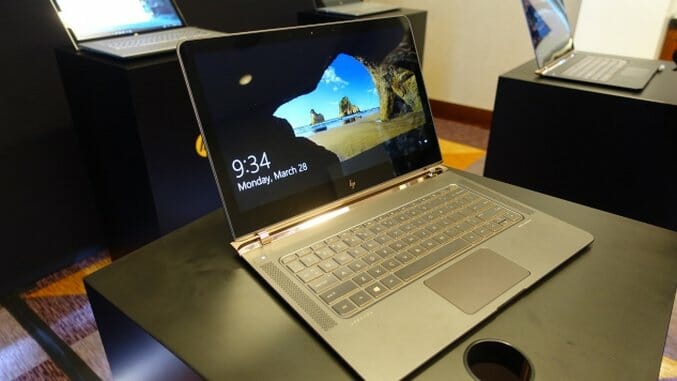HP Spectre 13 Hands-on

With its eyes set squarely on the geek-chic segment, HP’s new Spectre 13 ($1,169) for 2016 is a laptop that packs in as much muscles as it does beauty. The notebook’s impossibly thin profile and premium CNC metal construction immediately draw comparisons with the rival Apple MacBook, and HP has a winner in its portfolio as the Spectre is thinner, more powerful and, in many ways, more usable than Apple’s anorexic notebook.
“We built the Spectre 13 to satisfy customer requirements in the premium segment,” an HP spokesperson told me in a meeting in San Francisco, California. “The bar for value is the highest in this segment, and customers demand more features and value for the price.”
HP’s spokesman began our conversation by humbly admitting that “HP had missed the bar in the past few years,” and that the return rate in this segment was the highest because of high expectations from customers. However, what HP showed me proves that the company is capable of leapfrogging this bar.
The result of HP’s research into consumer tastes and technology needs is the 2016 Spectre 13, a 13.3-inch Windows 10 laptop, which the company claims is the first Spectre clamshell since 2013. The laptop weighs only 2.45 pounds and is just 10.4mm thin. For comparison, Apple’s MacBook weighs 2.03 pounds and is 13.1mm at its thickest point, making the Spectre the world’s slimmest laptop, a title that was previously held by HP’s business class EliteBook Folio.
Jeweled Design The laptop comes with a machined aluminum top and keyboard deck in an Ash Silver color, which resembles a matte gunmetal finish. On the lid, HP is using a new stylized logo, which the company says is exclusive to the Spectre line. Rather than the traditional HP letters, the letters are now spelled using angled lines, giving it a more modern appeal.
The laptop comes with a machined aluminum top and keyboard deck in an Ash Silver color, which resembles a matte gunmetal finish. On the lid, HP is using a new stylized logo, which the company says is exclusive to the Spectre line. Rather than the traditional HP letters, the letters are now spelled using angled lines, giving it a more modern appeal.
The bottom is composed of carbon fiber to keep the weight down. What’s interesting about the design of the Spectre is that a small strip on the back of the lid where the laptop’s hinge is located is painted in a glossy Copper finish, giving the laptop a jewelry-like duo-tone design. The Copper, to my eyes, look more like a lighter 10 karat gold, and the glossy effect adds a nice accent to an otherwise understated notebook.
 I asked HP if the glossy finish was more prone to scratching in daily use, and I was assured that it hasn’t been an issue in the company’s rigorous testing. Two of the three prototype Spectre 13 units that HP showed me came with some fine hairline scratches that were noticeable on the glossy edge, but I didn’t notice any scuffs or scratches on the matte finish.
I asked HP if the glossy finish was more prone to scratching in daily use, and I was assured that it hasn’t been an issue in the company’s rigorous testing. Two of the three prototype Spectre 13 units that HP showed me came with some fine hairline scratches that were noticeable on the glossy edge, but I didn’t notice any scuffs or scratches on the matte finish.
Another area that HP had to focus on in order to keep the design slim is the hinge. Because of the lithe dimensions, HP wasn’t able to extend the hinge all the way to the back edge of the laptop using the barrel hinge design, something that Apple and other notebook manufacturers have used for some time now.
 Instead, the hinge comes from the inside portion of the glossy Copper finish strip on the back of the unit. HP told me that the company found its design inspiration from hinges on kitchen cabinets. Internal pistons help power the hinge and make it fluid to open. It’s just a shame that HP didn’t continue its jewelry inspiration by placing clear windows on the underside of the laptop to show the piston hinge in action, similar to how Swiss watches show the gears through an open window on the underside of fine horological pieces.
Instead, the hinge comes from the inside portion of the glossy Copper finish strip on the back of the unit. HP told me that the company found its design inspiration from hinges on kitchen cabinets. Internal pistons help power the hinge and make it fluid to open. It’s just a shame that HP didn’t continue its jewelry inspiration by placing clear windows on the underside of the laptop to show the piston hinge in action, similar to how Swiss watches show the gears through an open window on the underside of fine horological pieces.
The result is that when opened, the curved hinge gives the illusion that the screen is floating in the air, anchored by two curved stands on the base. The design gives the effect of a chip on the back of the laptop when the screen is open, making the back thicker than the rest of the notebook. This extra bit of thickness helps to accommodate the size of the rear-facing USB Type-C ports.
The Spectre 13 comes with three ports, two of which also support the Thunderbolt 3 protocol for maximum expandability. HP says that any of the three ports can be used to charge the laptop.
-

-

-

-

-

-

-

-

-

-

-

-

-

-

-

-

-

-

-

-

-

-

-

-

-

-

-

-

-

-

-

-

-

-

-

-

-

-

-

-

 Even more impressive than the Spectre’s svelte dimensions is the laptop’s performance. Whereas the MacBook ships with a more power conservative Intel Core m architecture processor, the Spectre ships with a more mainstream Intel Skylake Core i5 or i7 processor, meaning that it will offer more power and performance.
Even more impressive than the Spectre’s svelte dimensions is the laptop’s performance. Whereas the MacBook ships with a more power conservative Intel Core m architecture processor, the Spectre ships with a more mainstream Intel Skylake Core i5 or i7 processor, meaning that it will offer more power and performance. Where the MacBook apes the Spectre is the screen. The MacBook ships with a high resolution 2304 × 1440 resolution panel, whereas the Spectre makes due with a full HD display. I didn’t have any problems with the FHD panel, which provides wide viewing angles, but pixel-peepers may be disappointed that HP didn’t use a QHD or even UHD 4K panel on its premium flagship notebook.
Where the MacBook apes the Spectre is the screen. The MacBook ships with a high resolution 2304 × 1440 resolution panel, whereas the Spectre makes due with a full HD display. I didn’t have any problems with the FHD panel, which provides wide viewing angles, but pixel-peepers may be disappointed that HP didn’t use a QHD or even UHD 4K panel on its premium flagship notebook. Like the MacBook, touch isn’t even an option on the Spectre. If you want a touchscreen experience, HP suggests that you look at one of their new Envy notebooks or convertibles.
Like the MacBook, touch isn’t even an option on the Spectre. If you want a touchscreen experience, HP suggests that you look at one of their new Envy notebooks or convertibles. The Spectre comes with a full-size backlit keyboard that offers a great typing experience. Despite being even slimmer than the MacBook, the keyboard experience on the Spectre feels more natural than Apple’s shallow key design.
The Spectre comes with a full-size backlit keyboard that offers a great typing experience. Despite being even slimmer than the MacBook, the keyboard experience on the Spectre feels more natural than Apple’s shallow key design. The HP Spectre 13 is a beautifully crafted laptop that blends sophisticated styling with the latest technology. The Spectre 13 shows that you can create powerful hardware that doesn’t skimp on design. With its jeweled-inspired design, premium finish and ultra slim profile, HP has created the laptop to beat in 2016.
The HP Spectre 13 is a beautifully crafted laptop that blends sophisticated styling with the latest technology. The Spectre 13 shows that you can create powerful hardware that doesn’t skimp on design. With its jeweled-inspired design, premium finish and ultra slim profile, HP has created the laptop to beat in 2016.






































